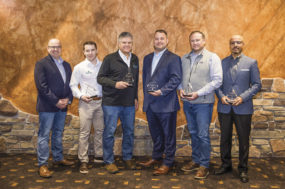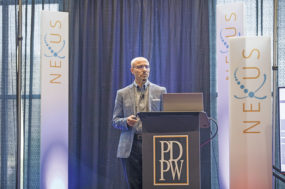In 1977, author Wendell Berry stood at the podium at Manchester College in Indiana. He was brought there to debate Earl Butz, the secretary of agriculture under Nixon, about the values of small farming compared to large-scale farming. His opening line summed up his entire argument:
“My basic assumption in talking about agriculture is that there’s more to it than just agriculture.”
Berry went on to discuss land stewardship, supporting rural communities and personal health, as well as everything the farmer produces in addition to a product, including various types of meaning. When a person gets up and milks cows, he or she doesn’t do so in a vacuum. The act of farming, and the way it is done, is situated within a family, a community and a generation of people. It has significance for how the farmer considers his or her existence, as well as how society views itself. As Berry said, “As I see it, the farmer standing in his field is not simply a component of a production machine. He stands where a lot of cultural lines meet.”
If Berry is right, then the arts become instrumental in registering and exploring that meaning, including literature, drama, paintings and various other mediums. It is a way of communicating to the rest of the world why agriculture is important, as well as a chance to provide farmers themselves with new ways to think about what they do. In helping tell the story of agriculture, the arts educate, consolidate political capital and help bridge the divide between the farming and non-farming world. With that in mind, here are three organizations that stand at the intersection of farming and the arts, endeavoring to do such work.
Writing the Land
Founded by Lis McLoughlin, Writing the Land connects poets to a conserved area as a means to foster human connections with that land, as well as help raise funds for its protection. Conserved lands include everything from conservation easements to farms using sustainable practices to wilderness preserves and special ecosystems. The poet visits the location and creates work inspired by the particular place, thereby inviting others to have a relationship with it as well. The poems and short essays of various Writing the Land poets are collected into anthologies, the proceeds of which benefit the land protection organizations that fund the conservation programs.
To date, Writing the Land has published nine anthologies, including Writing the Land: Foodways and Social Justice, that have collected the work of hundreds of poets and raised thousands of dollars for various land trusts. Every year, McLoughlin also hosts the two-day Authors and Artists Festival online, highlighting the work of several of these writers. The foundation has also published five other books of land-oriented poetry.
Poetry X Hunger
Also using verse to empower action, Poetry X Hunger joins in the fight against food insecurity. Founded by Dr. Hiram Larew, formerly the director of international programs at the USDA National Institute for Food and Agriculture, the initiative inspires and collects poetry that addresses the urgency of eliminating world hunger. Sometimes, in order to act, people need to feel compelled. Poetry X Hunger uses verse to complement statistics on global food needs as a way to reach both the general public and specific policy-makers.
Since its inception in 2017, Poetry X Hunger has raised awareness of how each of us can help combat world hunger, including contributing to both local and international programs. It has also collated an extensive database of “hunger” poems that are free for anyone to share or use in promotional material.
AgArts
“Imagine a healthy food system” is the byline of AgArts, co-founded by former Poet Laureate of Iowa Mary Swander. This nonprofit organization helps fund artistic projects that look to envision a better way of producing food by linking farmers, artists and community members.
AgArts has encouraged a wide range of ventures, including theatrical plays, musical festivals, educational tours, writing projects with at-risk youth, on-farm visual art, podcasts and much more. Paramount to AgArts’ work are the farm-to-artist residencies. Farmers host the artist, who then has an opportunity to learn about farming and create work inspired by what they find during the residency. These artists then give back to the community in the form of classes, readings or workshops. The program ensures that agriculture is represented and explored in the arts, helping foster the connection between a farm and the surrounding community.
These three organizations have one thing in common: They all see both farming and the arts as essential to making a better world. They recognize that farming is a complex act, as are the food systems based on it, and it is important that farming gets explored through various mediums. Through such initiatives, we can all understand ourselves better and why we farm, and that can be communicated to the rest of the world. When that happens, both those who farm and those who do not can work together to protect land, feed each other and support sustainable agriculture.
As has been said, there’s more to farming than just farming.





